Affiliate disclosure: This post may contain affiliate links. Please see our Privacy Policy.
Learn how to identify and forage for plantain, a valuable first-aid “weed” that’s easy to find- perfect for beginning foragers and medicine makers!
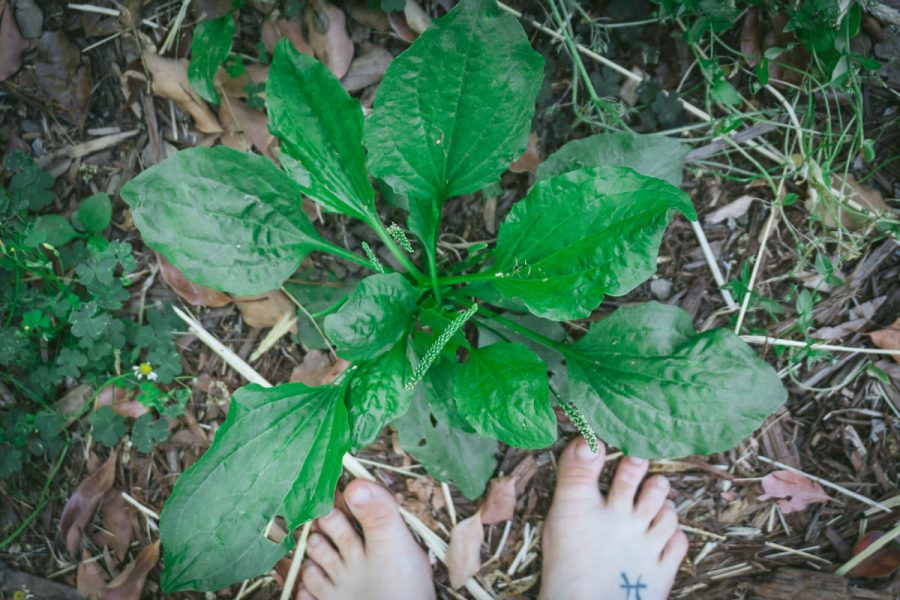
(This post was contributed by Melissa Keyser.)
I just returned home from traveling in Vermont, New Hampshire, and Maine for two weeks. I love exploring new areas to experience different ecosystems, discovering the native flora and fauna.
The East Coast of the US is such a different climate than the West Coast that I’m knowledgeable about. So many new-to-me plants I had no idea what they were, or different species of the genus I’m familiar with.
But one plant that I recognize, regardless of where I travel to, is the humble plantain.
White Man’s Footstep: the valuable naturalized weed
Plantain was the first wild plant I started working with, using it as a poultice while hiking to alleviate bites, scrapes, or draw out splinters. Even before I held that knowledge, I was drawn to this plant as a young child.
I’d pick the flower heads with their long stems, fold the stem over itself, and use it to snap off and to ‘shoot’ the flower cluster.
This plant was first brought to the US with the first colonizers, where it quickly spread. The native people called this plant “white man’s footstep”, as it followed the path of the white settlers, growing along wagon roads and railroads. The Latin name of the common plantain also echoes this, Plantago major, Plantago referring to the sole of the foot.
There is a wonderful section in Braiding Sweetgrass, one of the best books I’ve read this year, about plantain.
“At first the Native people were distrustful of a plant that came with so much trouble trailing behind. But those people knew that all things have a purpose and that we must not interfere with its fulfillment. When it became clear that White Man’s Footstep would be staying on Turtle Island, they began to learn about it’s gifts. This wise and generous plant, faithfully following the people, became an honored member of the plant community. White Man’s Footstep, generous and healing, grows with its leaves so close to the ground that each step is greeting to Mother Earth.”
Unlike many other introduced plants, plantain has never reached invasive status. Instead, it’s considered a naturalized plant, being a good neighbor and fitting in the ecosystem, not bullying or displacing the local plant residents.
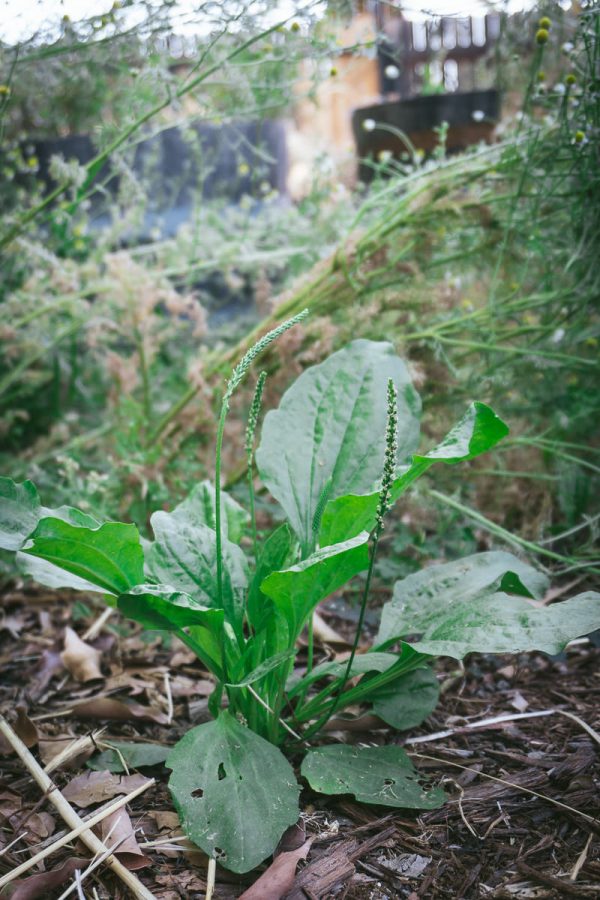
Why Forage for Plantain
Can it still be considered foraging if you gather weeds from your backyard?
Plantain, seen by many as a pesky lawn weed, is a great plant for beginner foragers and beginning medicine makers. It is a very common yet powerful herbal and first-aid plant.
It easily reproduces, so there is little risk of overharvesting. And if you have it growing in your own backyard, you truly know if there has been pesticide or herbicide exposure.
If you don’t already have some nearby, prepare some soil, preferably in sun, add some water, and wait. Plantain almost always accepts the invitation.
When to Find Plantain
In my area, plantain is a perennial that grows year-round. They produce by seed or by sections of roots left in the soil. If you live in a 4-season climate, they will likely appear in the spring.
Where to Find Plantain
They are commonly found in lawns, gardens, and roadsides, often in compacted and nutrient-poor soils. In my garden, they are clustered around the base of some of my containers, thriving off the drainage and growing in very hard soil.
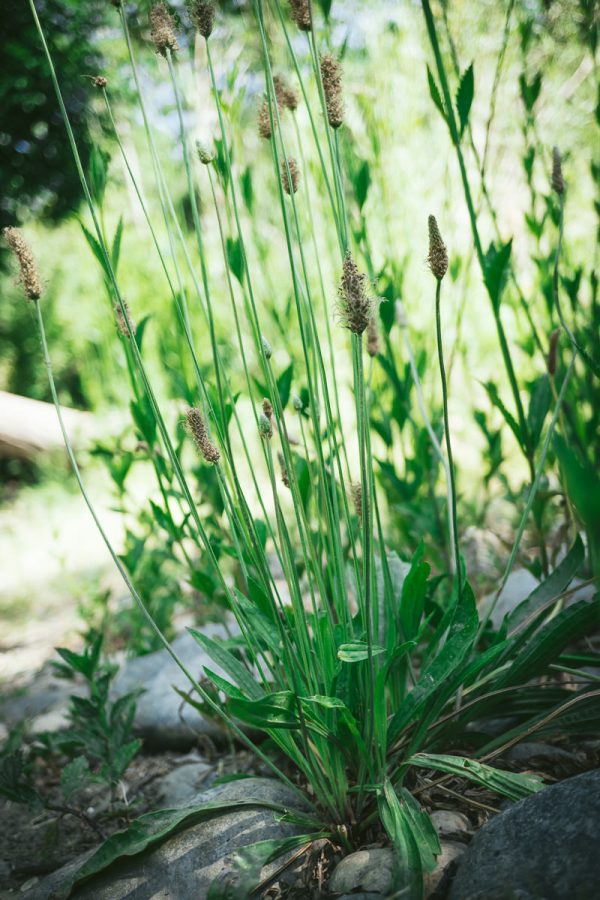
How to Identify Plantain
There are different types of plantain, the main varieties found as a “weed” are Broadleafed plantain, Plantago major, and Narrowleaf plantain Plantago lanceolata.
All varieties have parallel, fibrous veins that mark the leaves from end to end, and are covered with soft hairs.
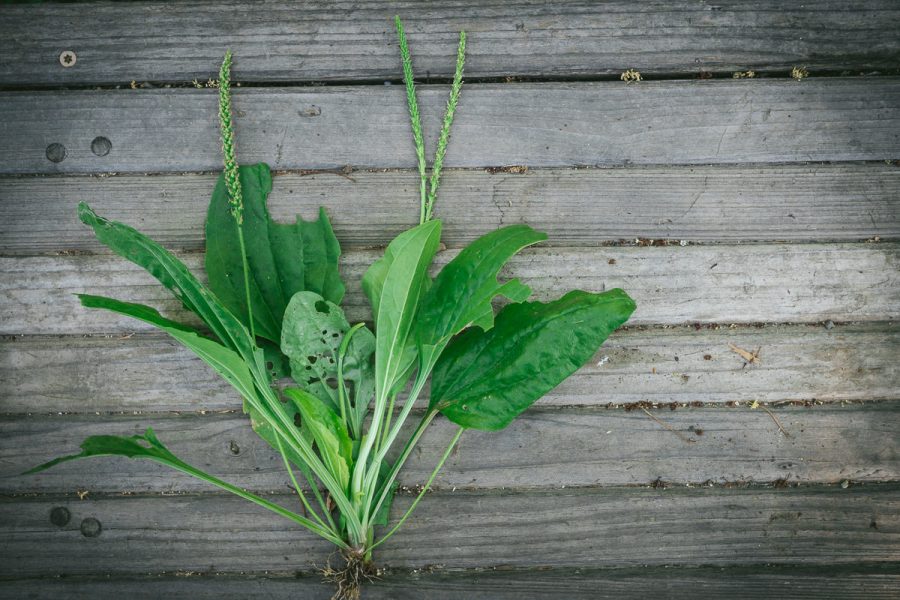
Broadleaf Plantain grows in a rosette shape, about 16” tall, but they are usually low to the ground, especially if they are mowed or walked on. The leaves are 2-7” long, and somewhat egg-shaped at the end of a thinner, V-shaped stem. The flowerheads rise 4-16” from the base of the plant, and are clusters of tiny green-white flowers along the top of thin stems.
Narrowleaf Plantain, also sometimes called Buckhorn, have thinner leaves, less than 1 ½” wide. There are 3-5 prominent veins that run the entire leaf length.
They can grow 3-10” long, and grow from the base quite erect. The flower stalks are 6-20” tall, and end in dense spikes of small flowers, with visible white stamens.
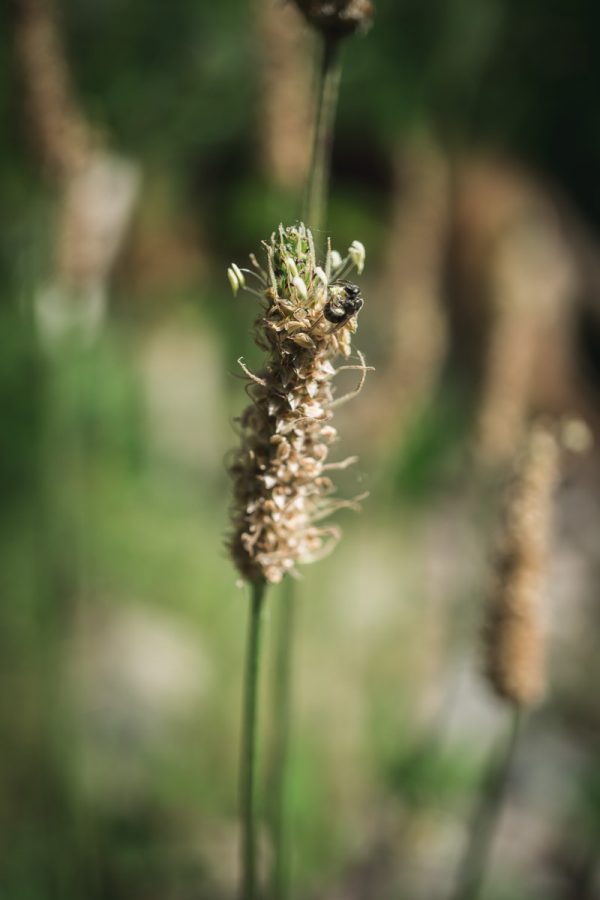
How to Harvest Plantain
Using small snips or your fingers, simply pull the leaves off at the base! If you’re using fresh, follow the instructions below. If you’re drying for future use, rinse in cool water and dry using one of these methods.
How to Use Plantain
All parts of plantain are usable! I mostly use it as a topical herb, to alleviate skin troubles like itching mosquito bites, or drawing out slivers that are too deep to fish out with tweezers.
The leaves can be chopped, mashed or placed right on the problem area. When hiking or out in the garden, I simply chew up a leaf or two and press it on my skin.
The leaves of plantain can also be brewed in a strong tea, and a cloth soaked in the tea can be placed directly over the area. On cuts or scrapes, mashed plantain can be placed directly on the wound to slow bleeding.
The leaves of plantain are also edible, but best consumed when young before they get tough and bitter. They are very nutrient-dense, containing protein, starch and several vitamins.
The seeds can be toasted and ground, and added to baked goods or breakfast porridge. They are also a mild laxative, a cultivated variety of plantain is used as the main ingredient in Metamucil.
In Europe, as I’ve learned from Instagram friends, the leaves are a traditional food. They are used as a wrap for a dolma like dish.
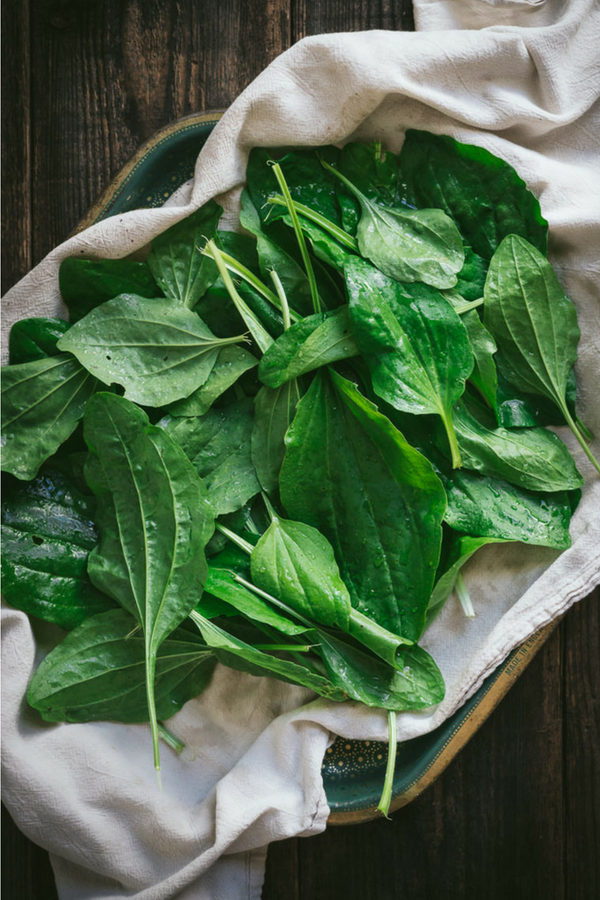
I mostly use plantain in salves, which is what I harvested these leaves for. After washing, I let them dry. Then, I steep the leaves in oils and then mix with beeswax, which I use for any skin infection or irritation.
If you need more inspiration, check out this article on 10 Things to Make with Plantain.
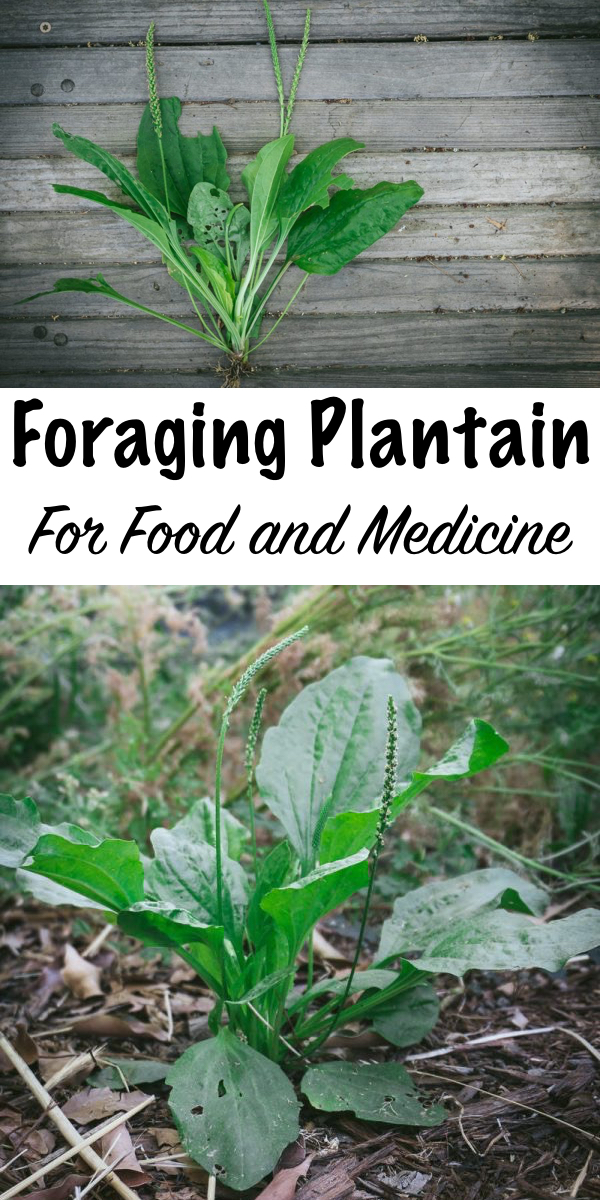
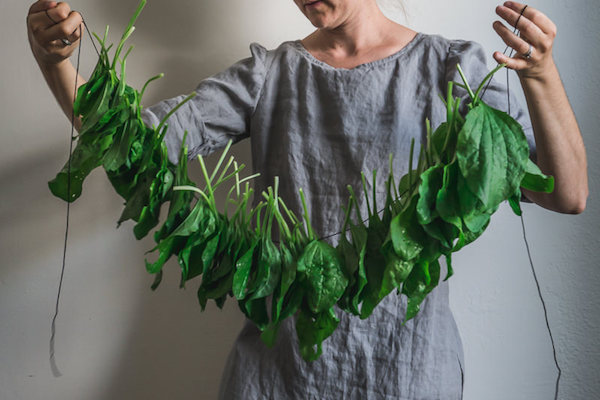




Super good website. What a fantastic wealth of information. Thank you
You’re very welcome. So glad you enjoyed it.
Not sure if I’ve got the right plant. Picture looks similar but with jagged edges
If it has jagged edges, then it isn’t plantain.
Any known use for the roots? Having a hard time finding information on this!
Thanks,
Maria
I haven’t really seen much information on using the roots. If you find some good information please come back and share.
I was born in Kentucky and plantain was a spring treat for us. We picked it early in the spring while it was still tender and we cooked it, depending on the amount we were able to find is how we cooked it. If we found a lot we would cook it by itself, with some ham or bacon for flavoring and it was eaten just like mustard or collard greens. If we weren’t able to find a lot, often we would cook it with other greens the same way. It was best by itself, but if we could find Poke greens it was better with the Poke than the other greens. When it could be found in large amounts we canned it just like we did with other vegetables. Plantain is just so good and it has it’s own unique flavor that is hard to describe. If you are able you should try it. I love it with a nice piece of buttered cornbread.
Do you know of any wild animal use of any of the Plantain species? I know that some horse owners will use if for forage and also for healing, but am trying to find out if animals in the wild will eat plant parts. Thanks for any info,
Corinne Martin
I believe there was an orangatan that recently used it to heal wound around his eye.
I was going to add plantain to my edible wild green list until I found that it aids in blood clotting. I have cloggef arteries and take aspirin to keep my blood thin. Sounds like plantain also has styptic properties, like yarrow, so I will have to consider using it topically.
“And if you have it growing in your own backyard, you truly know if there have been pesticide or herbicide exposure.”
Does this mean that if I find it in my yard, there has or hasn’t been chemical exposure?
It means that if you’re harvesting it in your yard, you already know if you’ve been using pesticides or herbicides on your land. Unless you have neighbors that cross in and spray for some reason or roommates that love spraying stuff, it’s pretty safe that way.
Oh! lol I completely misunderstood that sentence. Thank you!